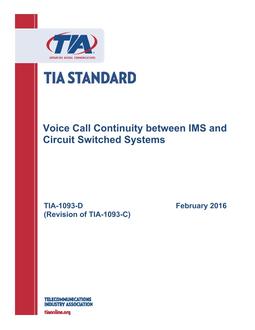-
-
Available Formats
- Availability
- Priced From ( in USD )
-
Available Formats
-
- Secure PDF 🔒
- Immediate download
-
$271.00Members pay $203.25
- Add to Cart
-
- Printed Edition
- Ships in 1-2 business days
-
$271.00Members pay $203.25
- Add to Cart
Customers Who Bought This Also Bought
-
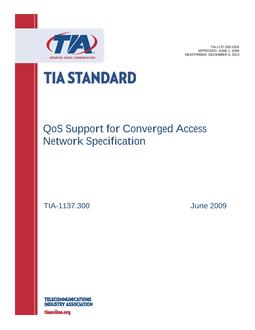
TIA TIA-1137.300
Priced From $93.00 -
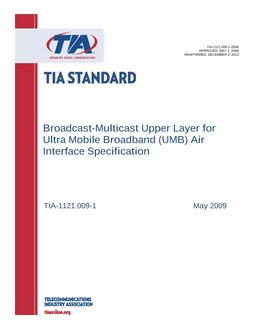
TIA TIA-1121.009-1
Priced From $184.00 -
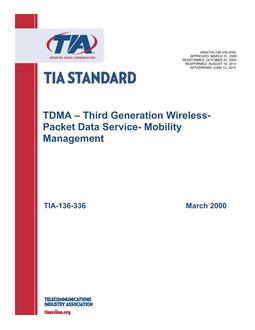
TIA TIA-136-336
Priced From $184.00 -
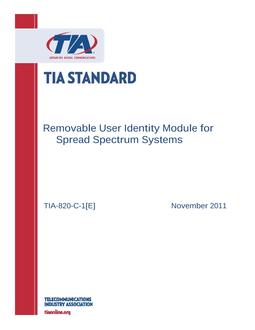
TIA TIA-820-C
Priced From $644.00
About This Item
Full Description
Voice call continuity allows users to move voice calls between the Circuit-Switched (CS) domain and the Multimedia Domain (MMD), connected through different Internet Protocol - Connectivity Access Networks (IPCANs) (e.g., WLAN, HRPD). This document defines an inter-technology Domain Transfer (DT) call model which supports procedures that allow a mobile subscriber to DT from an HRPD or WLAN multimedia session with a voice component to a 1x CS voice session and from a 1x CS voice session to a WLAN VoIP session.
It is the goal of this specification to allow the core network to know as precisely as possible the current accessibility of the User Equipment (UE) and to deliver services efficiently across the appropriate access network while minimizing the impact on the legacy systems.
The UEs in this specification include three types: HRPD/1x; E-UTRA/1x; and WLAN/1x handset. Single Radio HRPD/1x and E-UTRA/1x handsets are assumed to be incapable of simultaneous full-duplex radio communications with both an HRPD or E-UTRA radio access network and a 1x radio access network. Dual radio HRPD/1x, E-UTRA/1x, and WLAN /1x handsets are capable of being in simultaneous full-duplex communication with both a HRPD, E-UTRAN, or WLAN access ne twork and a 1x radio access network.
For Single radio handset, supplementary services and supplementary services continuity are not addressed in this specification (e.g., Call Waiting, Call Transfer, 3WC, Call Hold).
For Dual radio handset, supplementary services (e.g. Call Waiting, Call Hold, or 3WC) continuity and call intermediate states (e.g. Alerting) continuity from IMS to 1xCS are addressed in this specification.
The Stage 2 of this document specifies the interactions and signaling flows between a new functional entity in the MMD network called the VCC Application Server (VCC AS) and Access Transfer Control Function (ATCF) with the:
■ Serving-Call/Session Control Function (S-CSCF)
■ Home Location Register (HLR)
■ Home Subscriber Server (HSS)
■ High Rate Packet Data Access Terminal (HRPD AT)
■ Evolved Universal Terrestrial Radio Access User Equipment (E-UTRA UE)
■ Wireless Local Area Network (WLAN) Station (STA)
■ Mobile Switching Center (MSC)
■ Media Gateway Control Function (MGCF)
The Stage 3 specification in this document provides the protocol details for voice call continuity between the MMD based on the Session Initiation Protocol (SIP) [RFC 3261] and the Session Description Protocol (SDP) [RFC 2327] and the 3GPP2 CS domain which uses MAP and ISUP.
This document makes no VCC specific enhancements to SIP, SIP events or SDP, beyond those specified in [MMD Part-4].
This document is applicable to UEs, VCC AS, ATCF, MSC, and MGCF providing voice call continuity capabilities
Document History
-
TIA TIA-1093-D
currently
viewing
Voice Call Continuity between IMS and Circuit Switched Systems- Most Recent
-
TIA TIA-1093-C
Voice Call Continuity between IMS and Circuit Switched Systems- Historical Version
-
TIA TIA-1093-B
Voice Call Continuity between IMS and Circuit Switched Systems- Historical Version
-
TIA TIA-1093-A
Voice Call Continuity between IMS and Circuit Switched Systems- Historical Version
-
TIA TIA-1093
Voice Call Continuity between IMS and Circuit Switched Systems- Historical Version
